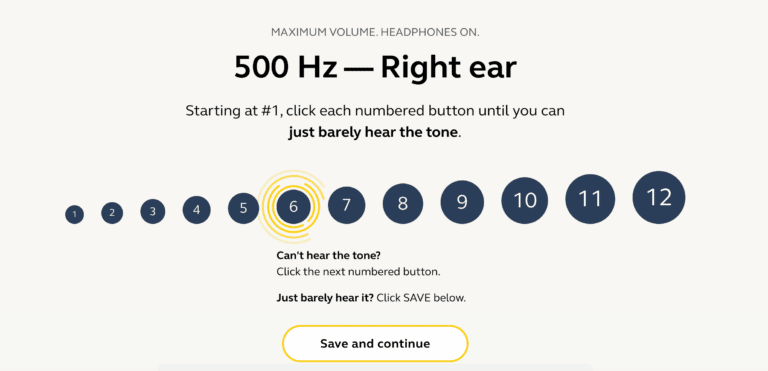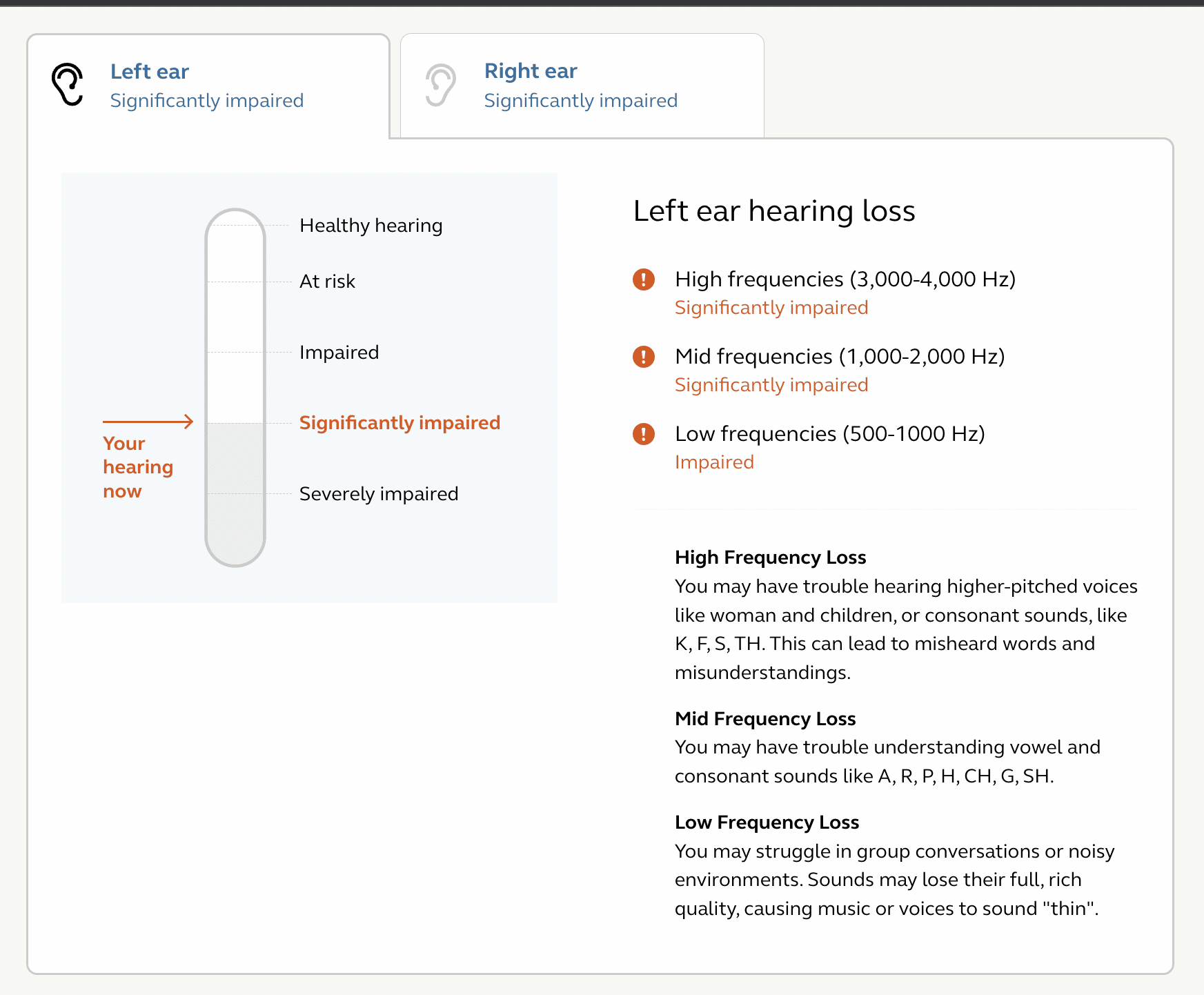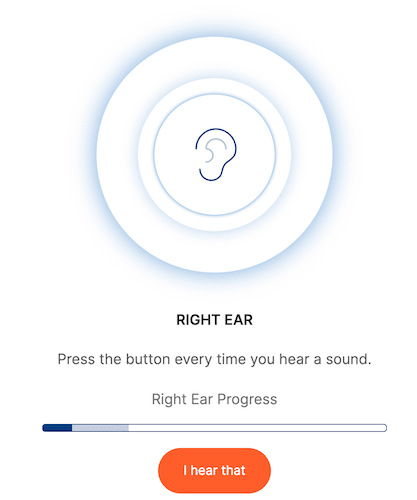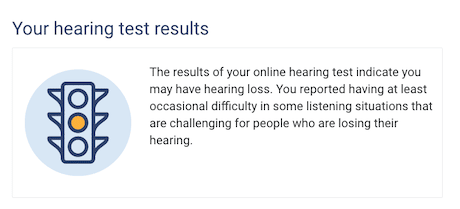Our team selected the Jabra Enhance online hearing test as “Easiest to Use” because it provides clear instructions in a simple format and only takes a few minutes to complete.
The 6 Best Online Hearing Tests of 2025: Expert Reviewed
Key Takeaways
- Online hearing tests are a convenient initial step to identify potential hearing loss.
- Tests vary in methodology, with some offering detailed results and follow-up options.
- Accurate results depend on proper setup and environment during the test.
Recognizing the signs of hearing loss in yourself or a loved one is an important step toward getting treatment. Hearing loss can negatively impact your relationships and overall quality of life, so early detection is essential—especially with hearing loss affecting one in three adults over 65, according to The National Institute on Deafness and Other Communication Disorders. [1] National Institute on Deafness and Communication Disorders. Quick Statistics About Hearing. Found on the internet at https://www.nidcd.nih.gov/health/statistics/quick-statistics-hearing
An online hearing test can help you determine if you have hearing loss and whether you need hearing aids. Our team took 15 different online hearing tests, and in this article we walk you through our choices for the six best free online hearing tests, how to take them, and what to look for in your assessment.
A quick look at the best online hearing tests
- Jabra Enhance: Easiest to Use
- Phonak: Simplest Results
- Eargo: Best for Virtual Follow-Up Appointments
- MDHearing: Best Detailed Results
- Best Buy: Best Retailer Test
- Healthy Hearing: Best Multiple-Choice Test
Table 1 Comparison of the best online hearing tests
| Cost | Free | Free | Free | Free | Free | Free |
| Test time (minutes) | 5 | 3 | 3–5 | 8 | 3–5 | 5 |
| Tests for | Tone frequency | Tone frequency | Tone frequency | Tone frequency | Background noise | Hearing experience |
| Email address required | Yes | Yes | Yes | Yes | No | No |
| Results | By email | By email | By email and immediately | By email and immediately | Immediately | Immediately |
| Follow up | Yes | Yes | Yes | Yes | No | Yes |
Easiest to Use: Jabra Enhance
Simplest Results: Phonak
Best for Virtual Follow-Up Appointments: Eargo
Best Detailed Results: MDHearing
Best Test Offered by a Retailer: Best Buy
Best Multiple Choice Test: Healthy Hearing
What is an online hearing test?
An online hearing test is a simple, often free tool you can use to test for hearing loss. “The results from an online hearing test can indicate whether you may have hearing loss, but you’ll still want to follow up with a professional,” said Amy Sarow, a practicing doctor of audiology based in Michigan.
While the online hearing test is a great starting point, it is not a comprehensive test and will not detect whether you have an underlying condition that’s causing your hearing loss. For a more comprehensive assessment, audiologists we spoke with recommended getting an in-person hearing test done first to rule out other causes of hearing loss that hearing aids can’t treat, such as a buildup of earwax.
If the results of the online test indicate you have severe or profound hearing loss, you should see an audiologist or hearing care specialist for a more comprehensive evaluation.
Online hearing tests vs. professional in-office tests
During an in-office visit, the hearing specialist or audiologist will perform a pure tone audiometry, which Mayfield Clinic in Cincinnati, Ohio, defines as “a painless, noninvasive hearing test that measures a person’s ability to hear different sounds, pitches, or frequencies.” [2] Mayfield Clinic. Hearing (Audiometry) Test. Found on the internet at https://mayfieldclinic.com/pe-hearing.htm
“Online tests can be a good introduction to hearing. The type of device you are using, the volume you have it set at, and the earpieces (or not) you use, can all impact the precision,” said Sarah Lundstrom, AuD, a certified member of the American Academy of Audiology and a member of the Florida Academy of Audiology
Brian Murray, a hearing instrument specialist in Raleigh, North Carolina, noted that audiologists will perform other tests, such as an otoscopy (looking into the ear canal) and bone conduction testing (if there is a problem in the outer or middle ear).
During an in-person test, you’ll enter a sound-calibrated (also known as “soundproof”) room or booth where a series of sounds at varying frequencies are played through headphones into your ears. The doctor performing the test will ask you to identify which frequencies you can hear clearly.
According to the American Speech-Language-Hearing Association (ASHA), following the initial test frequency of 1,000 Hz, “the audiologist should test, in order, 2,000, 3,000, 4,000, 6,000, and 8,000 Hz, followed by a retest of 1,000 Hz before testing 500, 250, and 125 Hz.” [3] American Speech-Language-Hearing Association. Guidelines for Manual Pure-Tone Threshold Audiometry. Found on the internet at https://www.asha.org/policy/gl2005-00014
What is an audiogram?
According to the ASHA, an audiogram is “a graph showing the results of a pure-tone hearing test,” which is a hearing test that “helps find the quietest sound you can hear at different pitches or frequencies.” [4] American Speech-Language-Hearing Association. The Audiogram. Found on the internet at https://www.asha.org/public/hearing/audiogram/ It shows the pattern and degree of your hearing loss per ear, as well as your ability to hear low or high pitches.
Some of the companies on this list provide you with a detailed audiogram after taking your assessment.
How to take an online test
To take an online hearing test, you’ll need headphones and a computer. Many online hearing tests instruct you to set up your environment by turning your volume up to 50%–100%, ensuring you’re in a quiet room, and plugging your headphones into your computer or connecting them via Bluetooth.
You’ll go through a series of prompts, depending what you’re testing for, such as speech, tone frequency, and background noise. After the test, you’ll receive results by email or immediately on the screen. Some online tests have follow-up care with a hearing care specialist or audiologist, which you can schedule online or request to be contacted by email or phone.
Who should take an online hearing test
“An online hearing test is a great first step for anyone curious about their hearing,” said Sarow. This tool can be a good option if you have signs of hearing loss.
Signs of hearing loss
Signs and symptoms of hearing loss may include the feeling that others’ voices are muffled or people are mumbling; difficulty understanding words, especially against background noise or in a crowd; and trouble hearing consonants, according to the Mayo Clinic. [5] Mayo Clinic. Hearing Loss. Found on the internet at https://www.mayoclinic.org/diseases-conditions/hearing-loss/symptoms-causes/syc-20373072 The Centers for Disease Control and Prevention (CDC) also notes that if you have ringing in the ears, need to turn up the volume on the television or radio, or are hypersensitive to certain sounds, these all could be signs of hearing loss. [6] Centers for Disease Control and Prevention. How Do I Know If I Have Hearing Loss Caused by Loud Noise. Found on the internet at https://www.cdc.gov/nceh/hearing_loss/how_do_i_know_if_i_have_hearing_loss.html
If you experience any of the above signs of hearing loss, experts encourage you to get a hearing test—and not to wait. That’s because people wait, on average, 10 years from realizing they have hearing loss to purchasing hearing aids, according to Johns Hopkins Medicine. [7] Johns Hopkins Medicine. The Hidden Risks of Hearing Loss. Found on the internet at https://www.hopkinsmedicine.org/health/wellness-and-prevention/the-hidden-risks-of-hearing-loss
And research compiled by ASHA shows that untreated hearing loss is linked to higher rates of depression, anxiety, dementia, cognitive decline, and social isolation. [8] American Speech-Language-Hearing Association. Untreated Hearing Loss in Adults. Found on the internet at https://www.asha.org/articles/untreated-hearing-loss-in-adults/ The same compilation of research found that being fit with hearing aids improves quality of life not only for the wearer but also their partner. Audiologists recommend starting with an in-person hearing test if you’ve never had a hearing test before.
How often to take an online hearing test
Both of the audiologists we interviewed for this article recommended hearing tests starting at 50–55 years old, or sooner if issues arise. After the initial hearing test, they advise retaking the test every year or two.
Who should not take an online hearing test?
“If you have tinnitus, dizziness, or ear pain or fullness, you should have a professional exam,” said Lundstrom.
Online tests can be a convenient and free starting point, but if you notice any of the following issues, consult with a hearing care professional:
- Fluid, pus, or blood coming from one or both ears
- Sudden change in hearing or loss in one ear
- Excessive ear wax or ear pain
- Buzzing in one or both ears
Pros and cons of online hearing tests
Online hearing tests have many advantages and potential drawbacks. Check out some of the top tests we’ve considered.
What to look for in the best online hearing tests
Type
First, make sure you understand the type of hearing test. Most online hearing tests use an air conduction test, which transmits sound vibrations into different parts of the ear (outer, middle, and inner ear). An in-person hearing test will use bone conduction, which uses a tool called a bone oscillator to transmit sound vibrations directly to the inner ear and cochlea. The cochlea is a spiral-shaped bone deep in your ear that plays a key role in the auditory system.
While an air conduction test may identify if you have hearing loss, a bone conduction test helps determine where the hearing loss is located in the ear.
Method
Next, make sure you know what method the test will use to test your hearing. Pure tone and word recognition are the most common types of online hearing tests.
- A pure tone test measures the softest sound you can hear in decibels (dB).
- Word recognition tests measure your ability to understand speech at a level that is comfortably heard.
“The most useful [online] test is the pure-tone screening, which more closely resembles a professional hearing test,” said Sarow. The majority of the tests described in this review are pure-tone screenings.
And Lundstrom noted that tests which use simulated background noise can be a great early indicator of hearing loss if the user is unable to decipher spoken words through the noise. An example of a background noise test is the one offered by Best Buy.
What to look for in a hearing aid
When searching for hearing aids, you’ll want to consider several factors, such as your degree of hearing loss, budget, and features. After consulting with a hearing care specialist or audiologist, if they determine you need hearing aids, consider the following:
- Degree of hearing loss: If you have mild to moderate hearing loss, you have a wider range of traditional and OTC hearing aid options. For those with more severe hearing loss, you will need a more advanced, prescription hearing aid that will be customized to your ears.
- Budget: In our team’s survey of hearing aid users, cost was the second-most important factor when shopping for hearing aids (the first was “ease of set up and use of devices”). Depending on your budget, you might consider more affordable hearing aid options, such as Jabra Enhance, Audien, or Lexie Hearing devices.
- Features: You might consider what features are important to you in a hearing aid. For example, do you want Bluetooth capabilities and access to a smartphone app for hearing aid adjustments? Do you prefer rechargeable hearing aids? Rechargeable batteries were a top-ranked feature in our team’s hearing aid survey.
Are online hearing tests accurate?
Online hearing tests can be just as accurate as in-person assessments, according to research from 2019. [9] Mosley, C, et al. Reliability of the Home Hearing Test: Implications for Public Health. Journal of the American Academy of Audiology. March 2019. Found on the internet at https://www.ncbi.nlm.nih.gov/pmc/articles/PMC6710072/pdf/nihms-1044717.pdf But the accuracy may depend on your testing set-up and environment. For example, if there’s a lot of background noise around you while taking the test (in addition to the background noise that’s part of the test), or your headphones aren’t fitted snugly enough to your ears, the results may not be accurate. Experts recommend using over-the-ear headphones (headphones that completely cover both ears) for online hearing tests, since they help block out background noise compared with earbud-style headphones.
It’s important to remember that an online hearing test can only detect your degree of hearing loss, while an in-person hearing test conducted by a hearing professional can diagnose possible causes. Many audiologists recommend starting with an in-person test if you’ve never had one.
What to do after taking an online hearing test
If your results show that you have hearing loss after completing an online hearing test, connect with a hearing care professional or an audiologist. Many of the hearing tests on this list offer phone or email follow-up care with audiologists or hearing care specialists. You can also visit a local hearing care clinic. From there, the hearing professional will help you determine the next steps or potential need for hearing aids.
Bottom line
While an in-person hearing exam is the best way to detect underlying conditions that may be causing your hearing loss, online hearing tests are a convenient way to determine if you have hearing loss without having to go into a clinic or office. This is one of the first steps to identifying whether you need hearing aids.
In this review, our team selected our top six free online hearing tests. Jabra Enhance won “Easiest to Use.” If you’re seeking more detailed results, you might consider the Phonak or MDHearing online hearing assessments, which were selected for “Simplest Results” and “Best Detailed Results,” respectively.
If your top concern is figuring how to schedule follow-up care, check out the Eargo online hearing test. It was selected as “Best for Virtual Follow-Up Appointments” for its easy scheduling calendar feature. Hesitant to go through a specific hearing aid company? Our team chose Best Buy as “Best Retailer Test,” compared with other retailers we tested.
And finally, if you don’t have headphones or would prefer a multiple-choice quiz, check out Healthy Hearing, our selection for “Best Multiple-Choice Test.”
Frequently Asked Questions
Yes, you can take a hearing test online. Many hearing aid companies offer this as a free option, including brands like Jabra Enhance and Eargo. Some retailers that sell over-the-counter hearing aids, like Best Buy, also have an online hearing test.
Yes, most online hearing tests are free.
Most tests recommend using headphones in the online hearing test, and you will get the best results using headphones that fit snugly on your ears, but it’s not required.
Finding the best online hearing test for you varies on a few factors. For example, what you want to test for, if you want to include your email address and phone number, or if you’re looking for instant results versus emailed results. We suggest six options, such as the MDHearing and Jabra Enhance online hearing tests.
Research shows online hearing tests can be just as accurate as in-person assessments. Though, it’s dependent on your environment, like if there is background noise. An important note is while online hearing tests can detect if you have hearing loss, they can’t determine where the hearing loss newinates.
You are not required to take an online hearing test to purchase some over-the-counter hearing aids, such as Lexie or Eargo. But it’s recommended to consult with a professional hearing care specialist before buying a hearing aid.
The Pacific Audiology Clinic in Oregon recommends that you make sure your ears are not exposed to loud noise before taking a hearing test. [7] Johns Hopkins Medicine. The Hidden Risks of Hearing Loss. Found on the internet at https://www.hopkinsmedicine.org/health/wellness-and-prevention/the-hidden-risks-of-hearing-loss “Avoid any noise louder than a vacuum cleaner for about 12 hours before your hearing test.”
Have questions about this review? Email us at reviewsteam@ncoa.org.
Sources
- National Institute on Deafness and Communication Disorders. Quick Statistics About Hearing. Found on the internet at https://www.nidcd.nih.gov/health/statistics/quick-statistics-hearing
- Mayfield Clinic. Hearing (Audiometry) Test. Found on the internet at https://mayfieldclinic.com/pe-hearing.htm
- American Speech-Language-Hearing Association. Guidelines for Manual Pure-Tone Threshold Audiometry. Found on the internet at https://www.asha.org/policy/gl2005-00014
- American Speech-Language-Hearing Association. The Audiogram. Found on the internet at https://www.asha.org/public/hearing/audiogram/
- Mayo Clinic. Hearing Loss. Found on the internet at https://www.mayoclinic.org/diseases-conditions/hearing-loss/symptoms-causes/syc-20373072
- Centers for Disease Control and Prevention. How Do I Know If I Have Hearing Loss Caused by Loud Noise. Found on the internet at https://www.cdc.gov/nceh/hearing_loss/how_do_i_know_if_i_have_hearing_loss.html
- Johns Hopkins Medicine. The Hidden Risks of Hearing Loss. Found on the internet at https://www.hopkinsmedicine.org/health/wellness-and-prevention/the-hidden-risks-of-hearing-loss
- American Speech-Language-Hearing Association. Untreated Hearing Loss in Adults. Found on the internet at https://www.asha.org/articles/untreated-hearing-loss-in-adults/
- Mosley, C, et al. Reliability of the Home Hearing Test: Implications for Public Health. Journal of the American Academy of Audiology. March 2019. Found on the internet at https://www.ncbi.nlm.nih.gov/pmc/articles/PMC6710072/pdf/nihms-1044717.pdf





















